I. THE VALUATION QUESTION
Stock prices rose sharply during 2017 in a remarkably coordinated rally around the globe. Even for the most optimistic forecaster, the sheer magnitude of the surge and its unusually smooth trajectory probably came as unexpected, but welcome, surprises. Most notably, 2017 enjoyed the unprecedented outcomes of positive returns in each of the 12 months and no decline greater than -3% from a prior high.
We focus our attention here exclusively on the timely topic of valuations after highlighting that the global economy is “firing on all cylinders” in our last Market Insights. We specifically set out to answer one question. Are equity valuations frothy, elevated or fair?
We offer a number of differentiated observations on the key drivers of growth, inflation and interest rates in the following sections to answer this question.
Here are our key conclusions.
- More than a decade of easy global monetary policies has raised stock prices to at least fair valuations. The easy money from investing in unusually cheap assets is behind us.
- We understand how a more conventional comparison of stock valuations to unconditional long-term norms
may trigger the perception of frothy valuations. - We believe, however, that there are enough differences in current and future conditions of growth, inflation and interest rates to suggest that valuations are better described as elevated rather than frothy.
- The recent inflection point in the earnings growth trajectory may even provide a good reason for the current elevated valuations.
- More significantly, the future evolution of these key metrics is still likely to produce modest equity market returns. We believe that while future stock returns will be more muted than average, they will still offer a positive equity risk premium as compensation for their risk.
II. CURRENT VALUATIONS
We begin with a quick recap of current stock market valuations and then proceed to assess them relative to their likely fair value over the near and long-term.
The forward Price/Earnings (P/E) ratio for stocks, based on the next twelve months of estimated earnings, is currently measured at around 17 times. A trailing measure of P/E, based on the last 4 quarters of operating earnings, is 21 times earnings.
These valuations are above their long-term averages. We argue that they are less lofty when compared to conditional averages related to above-trend growth and below-trend inflation and interest rates.
III. ECONOMIC AND EARNINGS GROWTH
We begin with an assessment of economic growth and its influence on stock prices.
Economic Growth
We have observed in previous writings that while this economic cycle has been longer than average, it has not been stronger than average. The duration of this cycle is indisputably long at over 100 months and still counting. Investors who are focused narrowly on the sheer longevity of the cycle may argue for its demise based simply on old age. After all, conventional wisdom might suggest that the economy must be straining at its limits by now and ready to collapse under its own weight.
In reality, economic cycles don’t die from old age but rather from the attendant ailments of higher inflation and higher interest rates. The slow pace of U.S. growth in the aftermath of the Global Financial Crisis has postponed the onset of these potential headwinds.
Figure 1 best illustrates how the U.S. economy is not overheating at the moment and how the slack created from the Great Recession allows for a longer economic cycle.
Figure 1: Potential GDP vs Actual GDP
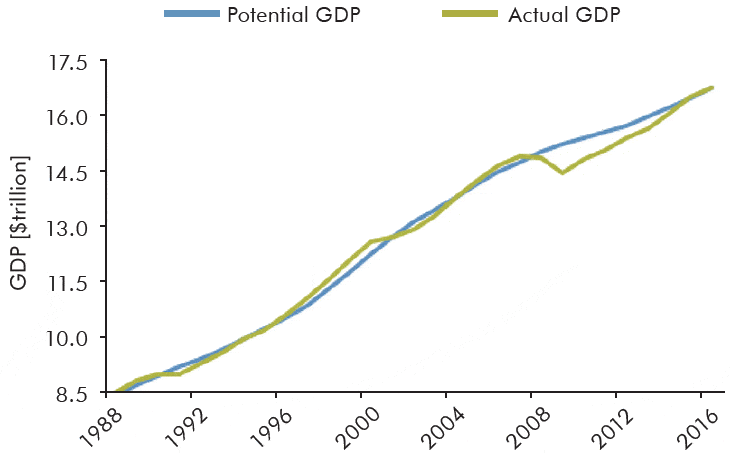
We compare actual real GDP growth in the U.S. to its potential growth over time. Potential growth is defined as the level of output an economy can produce at a constant inflation rate with full utilization of its capital and labor resources. Here are some key observations.
- Potential GDP growth in the U.S. appears to have shifted to a lower gear in the last decade or so. The secular demographic shift towards an aging population may make 2.5% the new normal for real potential GDP growth instead of the historical 3%.
- Actual real GDP growth rate in the U.S. has averaged an anemic 2% since the GFC. It has taken almost a decade to remove the slack in the economy created by the Great Recession. The U.S. economy has not yet tipped into inflationary territory.
- The fiscal stimulus from recent tax cuts will likely spur U.S. economic growth to a higher level in the near term. We believe, however, that its effects will be short-lived. This may allow the U.S. economy to sustain growth near its potential level for longer than expected.
- The synchronized, and now accelerating, revival of global growth significantly reduces the probability of a global recession in 2018. The added impetus of fiscal stimulus makes a U.S recession even less likely in the near term.
The macroeconomic backdrop is supportive of higher stock valuations.
Earnings Growth
Fluctuations in U.S. stock prices in the last few years are best explained by what has happened to corporate profits. The earnings cycle shown below in Figure 2 looks a bit different than the economic cycle above.
Figure 2: S&P 500 Earnings Per Share – LTM
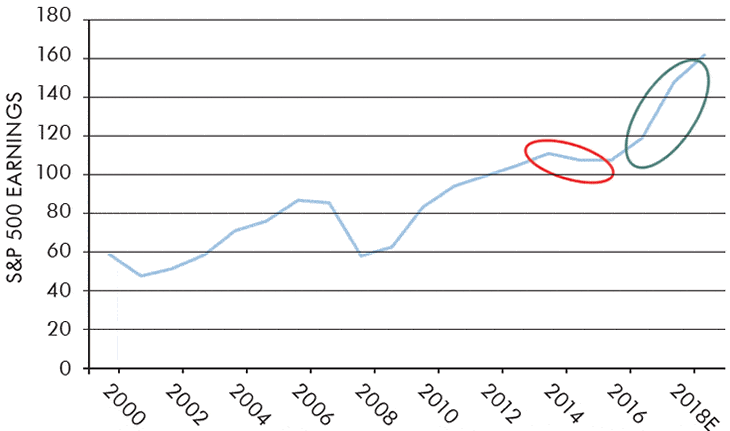
Even though the U.S. economy avoided a recession in the last decade, the earnings cycle was unable to escape one. As Figure 2 shows, a shallow earnings recession set in during Q3 2015 and lasted until late 2016, producing a cumulative decline in corporate profits of -8%. Most of the losses came from Energy companies and multinationals as oil fell to $26 per barrel and the dollar rose to multi-year highs during that time.
Stock prices reacted to this decline in earnings and made their recent lows in Q1 2016. Earnings growth in calendar year 2015 was negative and in 2016 was flat. The recovery in earnings growth began in Q3 2016 and it has been nothing short of spectacular since then. Earnings growth was 11% in 2017, was projected to be 13% in 2018 when the year began and is now estimated to be 16% after the announcement of tax cuts. Earnings growth for 2019 remains positive and may yet be revised higher as fiscal stimulus rolls through.
P/E ratios tend to rise when earnings rise and fall when earnings falter. The only exception to this rule of thumb is at the beginning and end of recessions. The forward P/E for U.S. stocks has risen by about 10% since the inflection point in the earnings cycle. This is consistent with improving fundamentals and also with the more nuanced heuristic that stock prices react faster and lead the actual, eventual or estimated recovery in earnings by several months.
We conclude our discussion on growth with a view that both economic and earnings growth are likely to remain above-trend in the near-term and are, therefore, supportive of higher stock valuations.
IV. INFLATION AND INTEREST RATES
Inflation
One of the more curious outcomes of this economic recovery has been the virtual absence of any meaningful inflation. In a remarkable breakdown of the Phillips curve which postulates that inflation rises as unemployment falls, inflation has been unusually quiescent even as unemployment has fallen to record low levels.
We have highlighted a number of reasons in the past to explain why inflation has been so muted in this cycle. Growth has been slower than average, globalization has led to more efficient allocation of labor, the composition of new jobs in the U.S. has shifted towards lower-paying jobs and even the increasingly mainstream phenomenon of “Amazonification” has pushed prices lower as information becomes more transparent.
We believe that the forces holding inflation lower are more secular in nature than transient. We expect that they will conspire to leave inflation contained in the future and well below the runaway levels seen in the past. We build on this thesis of modest inflation to argue in favor of higher stock valuations.
Figure 3 shows how stock valuations vary across different inflation regimes.
Figure 3: Average Last 12-Month P/E by Inflation Range (1950-Present)
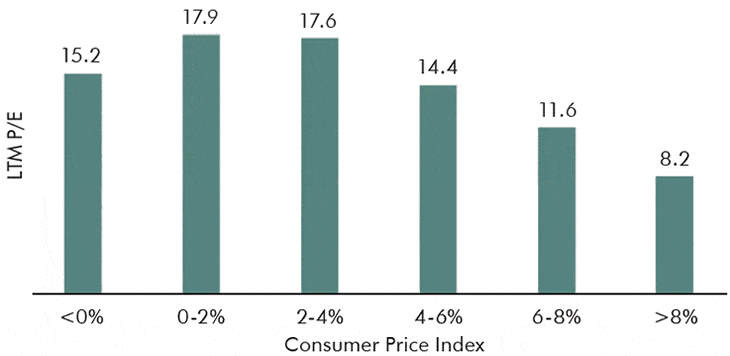
We look specifically at trailing 12-month P/E ratios during periods of different inflation levels and observe the following.
- Stocks don’t perform well during periods of deflation when inflation falls below zero. We know company profits decline rapidly in such periods as falling revenues crush profit margins.
- High levels of inflation are also detrimental to stock valuations as tighter monetary policy and higher interest rate compress P/E ratios.
- The range of inflation that is most conducive to higher P/Es is between 1% and 4%. The lower bound in this range is high enough to ward off fears of deflation and the upper bound is low enough to stave off hyperinflation. More meaningfully, it likely represents an economy that is neither too slow nor too fast to risk over-heating.
We believe that inflation will likely remain in this range over the foreseeable future and, therefore, support higher trailing P/E ratios than the long-term historical average.
Interest Rates
We hold a similar view that a combination of slower growth and lower inflation will also lead to lower-than-average interest rates after the normalization process is complete. The Fed’s dot plot projects a terminal median Fed Funds rate of less than 3%. Even with a normal term premium and an upward sloping yield curve, it is hard to see the 10-year Treasury yield come close to or exceeding 5%.
We move on to examine the relationship between 10-year Treasury yields and stock valuations in Figure 4.
Figure 4: Average NTM P/E by Interest Rate Regime (1950- Present)
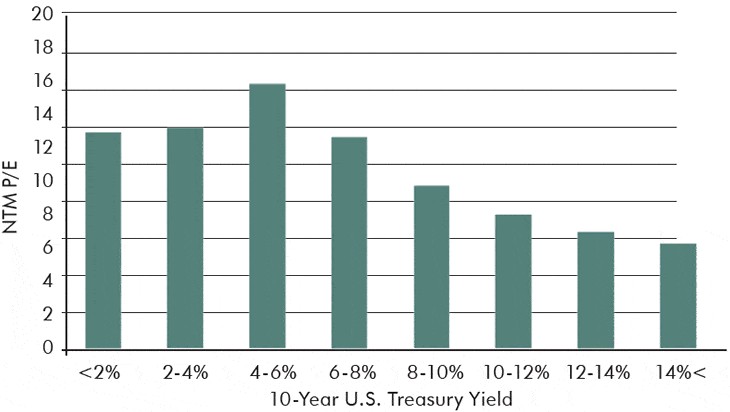
Here we look at 12-month forward P/Es across different interest rate regimes. Just as we saw with inflation, we find that stocks command the highest valuations when interest rates are neither too low nor too high. The 4-6% range for 10-year bond yields seems optimal for P/E ratios and probably represents an economy which is neither too cold nor too hot.
We take another look at the same relationship in a different visual depiction. Figure 5 shows a scatter plot of 12-month forward P/Es and 10-year Treasury yields.
Figure 5: S&P 500 NTM P/E and 10 Year Treasury Yields
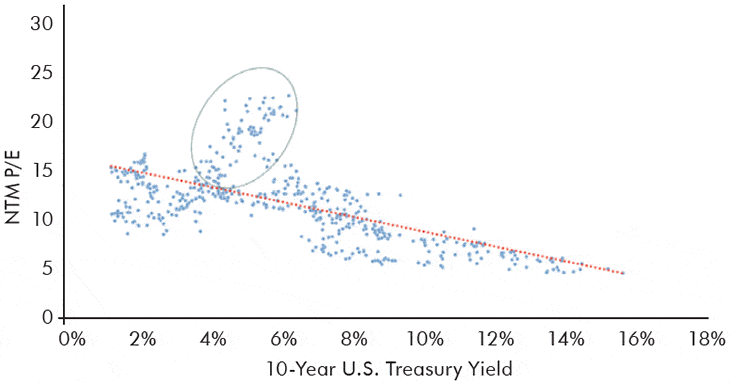
We see again that Treasury yields well below 4% or well above 6% produce lower and below-trend P/Es. On the other hand, 10-year Treasury yields in the 4-6% range support significantly higher and above-trend P/Es. Our view on interest rates is supportive of higher forward P/Es than the long-term average.
IV. INFLATION AND INTEREST RATES
Stock valuations have moved higher against a backdrop of synchronized global growth, resurgent earnings growth, low inflation and still-low global interest rates. We advance a framework here to better assess fair valuations in relation to this unique confluence of positive factors.
We find that stock valuations are admittedly high. A comparison to long-term, unconditional averages might suggest that they are indeed frothy. But we view today’s stock valuations through the lens of a conditional comparison. Conditioned on above-trend growth in the near term and below-trend inflation and interest rates over a longer term, stock valuations are better described as elevated as opposed to excessive.
We conclude our discussion by projecting out a future trajectory for P/E ratios and their impact on stock returns. We do anticipate a compression of P/E ratios going forward. As we show in Figure 6, we don’t expect the P/E contraction to be as severe as many may fear.
Figure 6: S&P 500 NTM P/E
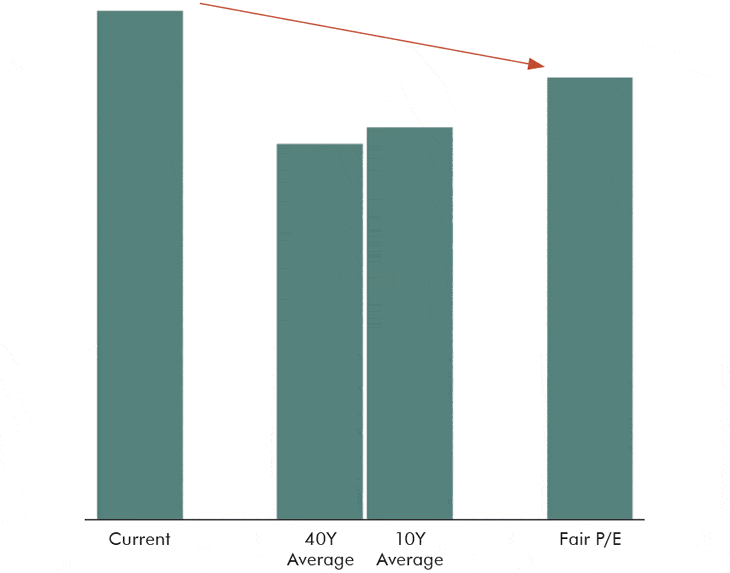
We stylistically show how the current 12-month forward P/E may evolve in the future. We deem it less likely to revert back to the 40-year or even 10-year average. We are more inclined to project a multiple compression back to a higher “fair” P/E that we believe is more reflective of the New Normal described above.
We summarize our final thoughts below.
- We believe earnings growth will offset the rerating of stock valuations.
- We expect that the bulk of the reversion in P/E multiples will materialize over a longer horizon rather than in the next couple of years.
- The annualized decrement to future returns from lower valuations is likely to be between -1% and -2% and should be more than covered by dividends, share buybacks, and earnings growth to generate positive long-term returns.
- We expect longer-term equity returns to be in the 5% to 7%range with the prospect of more upside in the near term.
Investment and Wealth Management Services are provided by Whittier Trust Company and The Whittier Trust Company of Nevada, Inc. (referred to herein individually and collectively as “Whittier Trust”), state-chartered trust companies wholly owned by Whittier Holdings, Inc. (“WHI”), a closely held holding company. WHI may utilize the services of its subsidiary, Belridge Capital, LLC, a state registered investment advisor, to provide sub-advisory services for certain accounts and proprietary private fund investments.
This paper is provided for informational purposes only. The views expressed by Whittier Trust’s Chief Investment Officer are as of a particular point in time and are subject to change without notice. The information and opinions presented herein have been obtained from, or are based on, sources believed by Whittier Trust to be reliable, but Whittier Trust makes no representation as to their accuracy or completeness. Actual events or results may differ materially from those reflected or contemplated herein. Although the information provided is carefully reviewed, Whittier Trust cannot be held responsible for any direct or incidental loss resulting from applying any of the information provided. Company references are provided for illustrative purposes only and should not be construed as investment advice or a recommendation to purchase, sell or hold any security. Past performance is no guarantee of future results and no investment strategy can guarantee profit or protection against losses. These materials may not be reproduced or distributed without Whittier Trust’s prior written consent.
Bloomberg TV
Whitter’s CIO Says Biggest Market Dynamic Is Growth Story
Whittier Trust Chief Investment Officer Sandip Bhagat discusses the markets and his investment thoughts. He speaks on “Bloomberg Daybreak: Asia.”
What impact do geopolitical risks have on the equity market? Will energy prices continue to rise? And will corporate earnings meet Wall Street forecasts in the first quarter? Sandip Bhagat, CIO, Whitter Trust discusses with Bloomberg TV.
“We believe that while future stock returns will be more muted than average, they will still offer a positive equity risk premium as compensation for their risk.”
“The slow pace of U.S. growth in the aftermath of the Global Financial Crisis has postponed the onset of potential headwinds.”
“We believe that the forces holding inflation lower are more secular in nature than transient. We expect that they will conspire to leave inflation contained in the future and well below the runaway levels seen in the past.”
“We hold a similar view that a combination of slower growth and lower inflation will also lead to lower-than-average interest rates after the normalization process is complete.”
“Conditioned on above-trend growth in the near term and below-trend inflation and interest rates over a longer term, stock valuations are better described as elevated as opposed to excessive.”
From Investments to Family Office to Trustee Services and more, we are your single-source solution.

